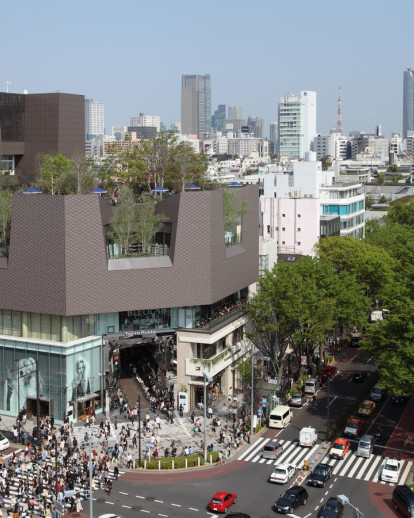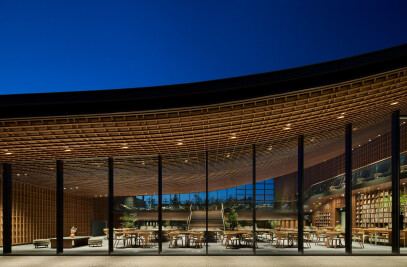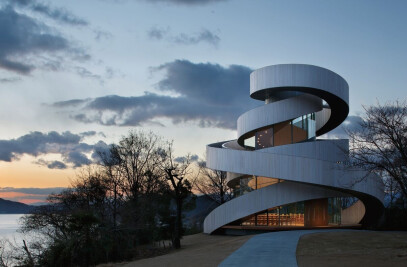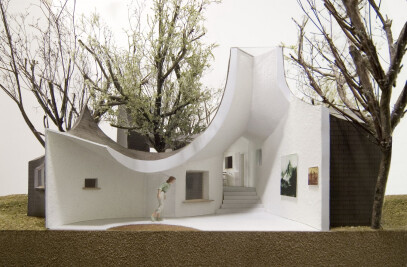A Fusion of Trees and Architecture, Floating above the Avenue
Omotesando, an avenue lined with the flagship stores of international fashion brands, is one of Japan’s foremost fashion streets. As the frontal (“Omote”) approach to the wooded compound of Meiji Shrine, the avenue is lined on both sides with zelkova trees. The branches of the trees form a canopy over the avenue and provide an experience of shopping under sunlight filtering through trees. An environment that blends architectural spaces with spaces under trees—such is the special character of Omotesando, we felt, and we therefore proposed a style of environment giving emphasis to this special character.
In concrete terms, we sought to give the space of the avenue below the trees a phased connection with the upper portion of the building, by floating in the sky a volume that merges the building with the zelkova trees. This not only allows birds and butterflies to easily ascend to the roof-top forest; a roof garden there also gives people an incentive to visit the building. Commercially, a shower-like effect of customers spilling down from the top floor to the floors below is produced.
We first laid out terraces and located trees on the roof and in peripheral spaces—areas of the building receiving maximum sunlight and, moreover, enjoying unlimited views of the intersection. We then created a volume three or more stories in height. As a result, the spreading branches of trees displaced portions of the building’s interior, and the terrace had to be elevated to the height of the trees’ root clumps. We nevertheless chose to embrace these restrictive conditions and use them positively to set up a feeling of intimacy between the trees and visitors. By establishing polygonal steps on the terrace, similar in appearance to the polyporaceae (bracket fungi) that grow at the base of trees, we could fill in the height difference created by the root clumps and produce a terrace of mortar shape. The polygonal steps have a multiplicity of meanings, for they serve not only as steps but also as chairs and tables. Through them, users enter a physical dialogue with the building.
What particularly charmed us about the mortar-shape terrace is how visitors naturally gravitate to the lower levels of the terrace, seeking a center. There, the visitors seat themselves in the countless nooks around the terrace and share the scenery before them. In these times, when Internet shopping is on the rise, it is important for commercial spaces to maximize the value they possess that cannot be replicated online. We felt that the relaxed sense of unity one feels in this comfortable environment abounding with distinctive places and pleasant physical experiences is precisely the quality demanded of commercial facilities in the future.
A Kaleidoscope-like Entrance Tube
Memory of the site’s past has been maintained in the entrance tube leading visitors to upper floors. The tube is a great mirrored space, its mirrors recalling the mirror wall cladding of the Central Apartments, which once occupied the site (a building that came to symbolize Sixties and Seventies youth culture). To see fashionably costumed people reflected repetitively in the mirrors, like colorful objects in a kaleidoscope, is dazzling in effect. A special sense of excitement evocative of the fashion world is produced, and the ride on the escalator becomes a rich experience. Attracted by the mirrored reflections of people passing through the intersection, one peers into the tube. On riding up the escalator, a great atrium appears with tree-filtered light spilling down from a skylight in the ceiling. Thus begins a shopping experience true in character to Omotesando.
Employing Light to Produce a Façade of Varying Expression
The external wall cladding is a composition of polygons that gives the wall a different appearance depending on how light strikes it. The functions demanded of the wall, in terms of performance and legal requirements, are borne by the extruded cement panels that form the backing. To this backing the aluminum polygonal panels were attached, using rotatable metal fittings designed to absorb seismic movement. The pressed-aluminum panels protrude in shape, with the peak of the protrusion off-center. During its attachment, each panel was rotated 120 degrees to produce a composition of off-center polygons having three different orientations.
Scenery reflected in the entrance tube, which opens on the intersection, changes with the season and time of day, and the tube presents a new appearance with each visit. To enable fine angle adjustment of the triangular mirror panels during their attachment, round pipes are employed as backing along the panel joints, and the panels attached to the pipes using hinges. Unavoidably, the mirror panels will appear to leap out at one, but this assembly method enabled us to free them from geometric rigidity and form a spatial device that softly encloses people passing within.
A volume that merges greenery with architecture floats in the sky above Omotesando. In order to meld the building with the bustling store-lined avenue, the first floor tenant stores have each been allowed to freely design its own façade. As a result, each store is distinct from the building’s upper floors and neighboring stores, and an impression of independent stores, each on its own site, is produced. Thus, we have fused commercial logic and the logic of environmental greenery in the design of the building.

































